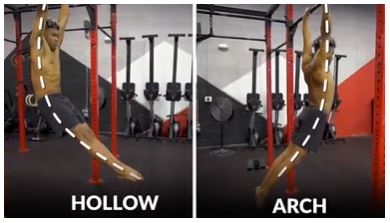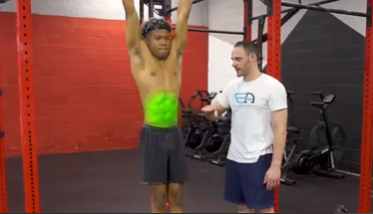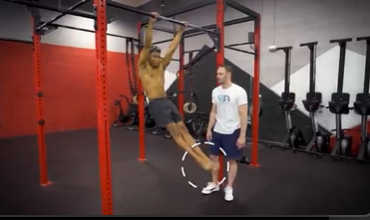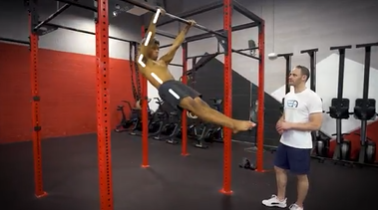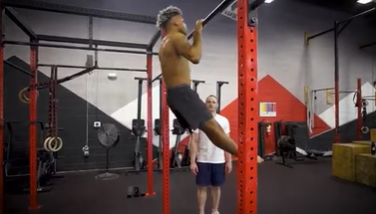Are you ready to elevate your fitness and unlock the impressive world of kipping muscle-ups on the bar?🤯
Progressing towards a flawless kipping muscle up requires a systematic approach, building upon fundamental positions, and refining your technique. As with any complex skill, building a strong foundation and incrementally advancing your technique and strength is essential.
Explore various techniques, cues, and exercises to help you unlock the kipping muscle-up’s full potential.
🔥This article will cover various stages of the progression, from establishing the essential hollow and arch positions to combining the pull-up motion with the dynamic kip swing.
⚡️Kipping Muscle-Ups on a Bar Overview
Kipping muscle ups on the bar is a dynamic and impressive gymnastic skill that showcases strength, technique, and coordination. It involves a combination of explosive pulling power, a fluid kip swing, and precise timing to transition smoothly from hanging to being on top of the bar.
Mastering this skill offers various benefits, including functional fitness, work-outs versatility, and a rewarding sense of accomplishment. Progressing through a step-by-step approach allows for a strong foundation, improved technique, and increased strength, leading to the joy of conquering this exciting movement.
✨12 Progressions to Kipping Muscle Ups on Bar
From establishing fundamental positions to achieving smooth and flawless transitions, each progression enhances strength, technique, and coordination. Whether you’re a seasoned athlete or a fitness enthusiast seeking a new challenge, these steps will pave the way for your success in conquering this dynamic gymnastic skill.
Check out our article on 📍Master the Art of Kipping Muscle-Ups: Your Ultimate Guide to Perfect Technique!
👊Progression 1: Hanging Hallow/Arch Positions
First, you must learn how to create the hollow and arch positions while hanging on the bar. These positions involve coordinated chest, shoulder, and core movements. Aim for smooth, curved shapes, and focus on keeping your chest in front of or behind the bar. These static holds will set the foundation for the dynamic movements ahead.
👊Progression 2: Hanging Shoulder Kips
Now, transition to a dynamic kip swing. Start by jumping up and gripping the bar with an overhand grip. Keep your abdominals tight and your legs straight and together. Initiate the kip swing by alternating rapidly between the hollow and arch positions. During the learning phase, focus on creating a smooth, continuous motion without introducing hip, knee, or shoulder angles.
👊Progression 3: Pull-up Pushaway to 3x Shoulder Kips
This will combine a pull-up motion with the kip swing. Hang with a straight body and legs together, then perform a pull-up. Afterward, execute three kip swings, shifting your chest forward while bringing your feet back, then reverse the movement. This combination sets the stage for the arced trajectory necessary to get your body on top of the bar.
👊Progression 4: Bar Distance Pulls
In this phase, you will explore the importance of an arced trajectory for the kipping pull-up and muscle-up. The movement should not be straight up and down; instead, it needs to be curved or arced to get your body on top of the bar.
To transition from the tap swing to the pull-up, we introduce the concept of pushing down on the bar with straight arms and elevating the shoulders. This technique, known as the bar distance pull, is essential for mastering the kipping muscle up.
Start by hanging on the bar, engaging your lats, and actively pushing the bar down. Focus on moving your shoulders behind the bar and upward while keeping your arms straight. This motion sets the foundation for smoothly transitioning to the next progression and achieving a flawless kipping muscle up.
👊Progression 5: Embrace the Kip Swing with Shoulder Elevation
Now, let’s take your kip swing to the next level by introducing shoulder elevation. This phase is a crucial step just before you perform the pull-up itself.
Combine your regular kip swing with the bar distance pull to execute the kip swing with elevation. Begin with the normal kip swing motion, focusing on the smooth alternation between the hollow and arch positions.
As you swing back, gradually raise your shoulders by actively pushing down on the bar with your arms straight. This elevation of the shoulders is a pivotal part of the movement, preparing you for the pull-up phase.
Mastering the kip swing with shoulder elevation is a significant milestone in your progression toward the kipping muscle up. It sets the stage for the final pull-up action, bringing you one step closer to accomplishing this dynamic gymnastic skill on the bar.
👊Progression 6: Kipping Pull-Up
Pull your chin over the bar at the apex by repeating the kip swing with elevation. This explosive and fuller pull is essential for elevating your kipping pull-up technique. After reaching the peak, return to the kip swings to prepare for continuous reps.
👊Progression 7: Achieving Chest-to-Bar Pushaway to 3 Shoulder Kips
Now, let’s elevate your kipping pull-up by focusing on getting your chest to the bar. This requires a more explosive and fuller pull, generating the necessary momentum.
As you initiate the pull, aim to bring your chest to the bar at the apex of the movement. Emphasize an explosive upward pull to achieve this position.
After reaching the chest-to-bar position, smoothly transition back to the kip swings. This skill is essential for mastering consecutive reps, allowing you to merge multiple kipping muscles ups back-to-back.
Developing the chest-to-bar push away to three shoulder kips will enhance your overall fluidity and efficiency during the kipping muscle up.
👊Progression 8: Kipping Chest to Bar and Belly Button Pull-ups – Making Connections
Great job on your progress! Now, let’s take it a step further by working on back-to-back kipping chest to bar and even venturing into kipping belly button pull-ups.
The key to mastering these connections is returning to a hollow position after each rep. This allows you to seamlessly resume the next kip swing. Timing and coordination are crucial in this phase.
Practice linking the kipping chest to bar pull-ups consecutively, and then challenge yourself to bring your body up to the belly button level. Focus on maintaining control and rhythm, ensuring smooth transitions between each movement.
Developing these connections will take your kipping muscle-ups to a new level of fluidity and grace.
👊Progression 9: Bar Muscle Up Negatives
Bar muscle-up negatives are an effective way to build strength and prepare for the full bar muscle-up. Here’s how to perform them:
- Use an elevated surface, like a box or a bench, to start the support on top of the bar.
- Perform an eccentric dip, lowering your body slowly, and aim to get your chest as close to the bar as possible.
- While maintaining control, lower your legs in front of you into a hollow position until you reach a hanging position.
- Once at the bottom, repeat the movement by hopping back up to the top, returning to the support position.
Bar muscle-up negatives target the key muscles involved in the full muscle-up while also allowing you to practice the transition and coordination required for the movement. Incorporate these negatives into your training to build the strength and technique necessary to easily conquer the bar muscle.
👊Progression 10: Jumping Muscle Up
Now, we introduce the jumping muscle up, an essential step towards achieving the full muscle up. Here’s how to perform it:
- Utilize the elevated surface from earlier to give yourself some added height for the jump.
- Begin the movement by jumping through the range of motion required for the muscle up.
- During the jump, pay close attention to how your hands need to shift from the hang position to the support position on top of the bar.
- As you complete the jump, ensure a strong lockout at the top, fully extending your arms.
The jumping muscle up allows you to practice the transition and get a feel for the hand movement required for the full muscle up. Keep refining your technique, and you’ll be one step closer to conquering this challenging skill. Stay persistent, and the full muscle-up will be well within your reach!
👊Progression 11: Mini Dips
Mini dips are a critical component in developing the strength and coordination required for the bar muscle up. Here’s how to perform them:
- Begin at the top of the bar in a support position with your arms fully extended.
- Lower your body slightly by bending your elbows to perform the mini-dip motion.
- As you perform the mini dips, you may naturally bend at the hips to counterbalance the weight behind the bar.
Mini dips focus on the initial portion of the bar muscle up, building strength in the triceps and shoulders while also developing the coordination needed for the transition. Continue practicing these mini dips to reinforce the key movement pattern and bring you closer to achieving the full bar muscle-up.
👊Progression 12: Kipping Bar Muscle-Ups
Congratulations! You’ve reached the final progression towards mastering the kipping bar muscle-ups! It’s time to combine all the elements you’ve been working on. Here’s how to perform the kipping bar muscle up:
- Start with the tap swing, generating momentum for the movement.
- Progress to the kipping chest-to-belly button position, pulling your body up towards the bar.
- As you reach the apex of the movement, lean your shoulders over the bar, preparing for the transition.
- Finish the kipping bar muscle up with a concentric dip, pushing yourself up above the bar.
- Return to the starting position and repeat the entire sequence.
Executing the kipping bar muscle requires coordination, strength, and timing. Embrace this final challenge with determination and practice, and soon you’ll be executing impressive sets of kipping bar muscle-ups. Keep up the hard work, and enjoy the thrill of conquering this dynamic calisthenics skill!
Check out the full video for these 12 progressions to kipping muscle-ups on a bar:
For other progressions, check out related articles:
- 📍Pull-up Progressions: Step-by-step Guide
- 📍Planche Progressions
- 📍Dragon Flag Progressions, Benefits, Requirements, and Variations
🎯Kipping Muscle-Up Preparation: Strength, Endurance, and Skills
To achieve kipping muscle ups, developing skills, strength, and endurance are essential prerequisites.
Skills: Mastering fundamental skills such as the kip swing, hollow and arch positions, and understanding the mechanics of the movement are crucial. Skillful execution allows you to generate momentum efficiently, leading to smoother transitions during the kipping muscle up.
Strength: Building upper body and core strength is vital for executing the pulling motion required in the kipping muscle up. Strong lats, shoulders, and arms are essential for propelling your body upward during the kip swing and transitioning over the bar.
Endurance: Endurance plays a significant role, especially when attempting multiple kipping muscle-ups. Improved cardiovascular endurance ensures sustained effort during the movement, allowing you to perform consecutive repetitions more easily.
To achieve kipping muscle ups, dedicate time to skill-based drills, incorporate strength exercises such as 📍pull-ups, 📍dips, and 📍core work, and engage in cardiovascular workouts to enhance endurance.
🤔Why Progress?
📍Progressing in kipping muscle-ups is essential for building a strong foundation, improving technique, enhancing strength and coordination, and fostering a sense of achievement. It offers numerous benefits, including functional fitness, work-outs versatility, and a sense of joy and camaraderie.
Kipping muscle up progression is important for several reasons:
🤜Building a Strong Foundation
Progression allows you to establish a solid foundation in fundamental positions and techniques. This ensures you develop proper form and reduces the risk of injuries as you advance.
🤜Improved Technique
As you progress through each stage, your technique becomes more refined. This leads to smoother transitions, efficient movements, and enhanced overall performance.
🤜Increased Strength and Coordination
Kipping muscles require explosive pulling power and a fluid kip swing. Progressing through various drills helps develop the strength and coordination to execute the movement flawlessly.
🤜Sense of Achievement
Each step of the progression brings a sense of accomplishment, motivating you to push further and conquer new challenges. Successfully mastering the kipping muscle up is a rewarding achievement in itself.
🤜Versatility in Workouts
Once you’ve progressed through the skill, you can incorporate kipping muscle-ups into various workouts and routines. They add diversity and excitement to your fitness regimen.
🤜Functional Fitness
Kipping muscle-ups contribute to functional fitness, improving your ability to perform everyday movements easily and gracefully.
🤜Athletic Performance Enhancement
For athletes, mastering kipping muscle-ups can enhance overall athletic performance as it requires strength, flexibility, and body control.
🧐Frequently Asked Questions:
🔎What other equipment will I need to do kipping muscle-ups?
You’ll need access to a pull-up bar to perform kipping muscle ups, and optional equipment includes gymnastic rings, resistance bands, weighted vests, grip enhancers, gymnastics mats, and an elevated surface for practicing specific progressions.
🔎Are kipping muscle-ups safe for my shoulders and upper body?
When performed with proper form and progression, kipping muscle-ups are generally safe for your shoulders and upper body. However, it’s crucial to warm up adequately, engage in mobility exercises, and listen to your body to avoid overuse injuries.
🔎Is the kipping muscle up suitable for beginners, or do I need prior experience?
While kipping muscle up requires a certain level of strength and coordination, it is attainable for beginners with proper progression and practice. Establishing a solid foundation through fundamental positions is crucial before advancing gradually in strength and technique.
📌Conclusion:
Mastering the kipping muscle up on the bar requires dedication, practice, and a progressive approach. You’ll steadily progress toward achieving this impressive gymnastic skill by focusing on fundamental positions, incorporating dynamic kip swings, and building strength. Utilize the Movement Athlete app to access micro progressions and customized workouts. So, let’s dive in, embrace the process, and unlock the world of kipping muscle-ups on the bar!

